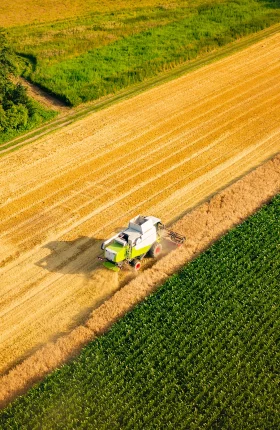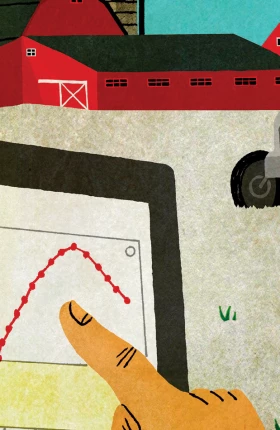Over the past 70 years, innovation in seeds, fertilizers, and crop protection products has reshaped the agriculture market and transformed the lives of billions around the world. Today each farmer in the US feeds 164 people, versus just 19 in 1940. In India, annual wheat production rose from 10 million tons in the 1960s to 73 million tons in 2006. Overall, global agricultural productivity has more than doubled.
In recent years, however, the pace of innovation among the large agricultural-input companies producing seed and crop protection products has slowed considerably. That’s a problem, and not just for those companies: further innovation is absolutely essential if farmers are to feed the world’s rapidly increasing population at the same time that they face the ongoing loss of arable land, increasing demand for more sustainably grown food, and the threat of climate change.
It doesn’t take much digging to uncover the reasons for the slowdown: the regulatory environment has tightened, concerns about personal and environmental safety are on the rise, and the cost of research and development has increased substantially.
If agricultural-input companies are to help meet the growing demand for food and remain competitive with new digitally driven businesses that are entering the field, they must break out of their traditional innovation models and get their product development efforts back on track fast. Doing so will require rigorous attention to customer needs, a sharply focused R&D program, rapid digitization, an openness to internal and external collaboration, and a truly innovative culture across the entire organization.
A Crop of Challenges
Beginning in the early 1990s, agricultural-input companies introduced a string of innovative seeds, pesticides, and herbicides that have since transformed how our food is grown. The first genetically modified crop, the Flavr Savr tomato, hit the market in 1994, followed in short order by numerous genetically modified corn, potato, and cotton varieties. Innovation in crop protection products was on the rise in the ’90s as well; Syngenta’s Amistar (Azoxystrobin), introduced in 1997, is still the world’s highest grossing fungicide. (See Exhibit 1.)
Since then, however, the pace of innovation has slowed considerably. Reasons for the slowdown are well understood, but hard to overcome: high costs, primarily the cost of product development in an increasingly restrictive regulatory environment; changes in consumer preferences; and the increased complexity of next-generation innovations. The number of active ingredients in new crop protection products introduced annually has fallen off dramatically, from more than 30 in 2000 to well under 20 by 2018. (See Exhibit 2.) Meanwhile, the number of patents filed for new seeds and traits reached a peak in 2012, but they too have declined since then.
Reasons for the innovation slowdown are well understood, but hard to overcome: high costs, changes in consumer preferences, and the increased complexity of next-generation innovations.
As a result, agricultural-input companies have been focusing largely on making incremental improvements to existing technologies, including the development of new stacked traits in corn, soybeans, and cotton, for example, and of new germplasm through gene sequencing and breeding innovations. And the latest crop protection products are mostly reformulations of past compounds.
Input companies continue to conduct research in seeds, traits, and chemical crop protection, of course. While the scientific and regulatory hurdles are still high, a number of areas offer the potential for breakthrough innovations. Examples include:
- Disease-Resistant Genetically Modified (GM) Traits. Developing seeds with new disease-resistant traits is highly complex, and while investment remains strong and several programs are ongoing, no successful disease-resistant trait is commercially available yet.
- GM Output Traits. Despite the scientific complexity of these efforts, agricultural-input companies continue to research ways to boost yield through genetically engineered and native output traits. So far, however, they have made only limited progress. Aside from the importance of developing new output traits in increasing agricultural productivity, success in doing so—in the form of significantly increased yields or further conservation of resources, for example—would go far toward increasing consumer acceptance of genetically engineered seeds.
- Hybrid Wheat. The first generation of hybrid wheat seeds has met with limited commercial success because, so far, the gains in yield have been too low to justify the complexity and cost of the effort. Companies continue to research this potentially valuable opportunity, but no real breakthroughs have been made. New genetic approaches one day may be able to overcome this hurdle.
- New Active Ingredients for Crop Protection. The number of active ingredients in late-stage development has drastically declined because of increased R&D costs, driven by higher regulatory and field-testing costs, as well as increasing scientific complexity.
- Herbicide Mode of Action in Crop Protection. No new mode of action—the manner in which an herbicide affects a plant—designed to overcome the increasing resistance of weeds to existing herbicides has been marketed in almost 30 years. Research is ongoing, but the likelihood of finding new modes, and thus of opening the field for the development of new active ingredients targeting them in the future, seems low, and few candidates are in current pipelines.
While some believe that the recent wave of consolidation in the industry may support new innovation as input companies gain broader capabilities, others (including some antitrust regulators) are concerned that greater market power could actually suppress innovation. Meanwhile, breakthrough innovation has largely moved to the digital and precision agriculture space, including farm automation and data-driven decision making to enable precise application of agricultural inputs.
Prospects for the Future
To shift the emphasis back toward high-impact innovation, input companies must come to terms with four key trends affecting the broader agricultural industry.
Changing Consumer Demand. Shifts in consumer demand and regulatory constraints are already forcing farmers to seek out new ways to boost yields sustainably. Consumers are demanding better, healthier, and more transparently produced food, a trend that is affecting the entire agricultural value chain. At the same time, regulators are requiring farmers to produce food using fewer resources and with fewer adverse impacts on the environment.
It is up to farmers to meet these demands, while keeping the cost of food low. And it’s up to input companies to provide the means to do so. This is no easy task. Increasingly strict regulations are limiting the kinds of seeds and crop protection products farmers can use just as many pests and weeds are becoming resistant to old products, making the development of alternatives much more urgent. As a result, the pressure on input suppliers to deliver a broad range of innovations will only increase in the coming decade.
Growing Challenges with New Seed and Crop Technologies. Agricultural-input companies are working on a number of technologies that have considerable potential for providing the innovations farmers need. Each of them, however, comes with challenges, as the following examples highlight.
- Gene-editing technologies, primarily CRISPR/Cas methods, have the potential to deliver real breakthroughs in creating new traits in a variety of crops, but they are unlikely to reach their full market potential unless regulations covering their use are loosened. The EU has already classified gene-edited crops as genetically modified organisms, and there is a risk that other countries might follow the EU’s lead.
- RNA interference, a technology that allows the suppression of specific genes in the target organism, offers the opportunity to overcome the problem of weed and pest resistance and advance pest management. However, because no product using this technology has yet been truly successful in the market, the initial excitement has flattened somewhat in the past several years.
- Microbiome technologies, the use of natural organisms like bacteria, yeasts, and fungi to strengthen plant and root systems, offer great promise. Their high degree of complexity, however, currently limits use cases and successes. Advancements in computing technology might help generate further advances in this area.
Growing Use of Technologies from Outside the Agriculture Sector. A range of technologies from outside the traditional agriculture sector is gaining ground among farmers. While advances in automation have long had a transformative influence on agriculture, these new technologies will be essential in increasing agricultural productivity while reducing the use of fertilizers, crop protection products, and natural and human resources. These include the further automation of existing equipment, new types of precision equipment (such as sensors, drones, and spraying machines), and new weeding and harvesting robots.
Investment in agricultural-technology companies has risen rapidly in recent years, with these companies receiving a larger and larger proportion of funding.
Just as promising, farmers and supporting companies are now collecting massive amounts of data and using powerful analytics tools to gain new insights. Precision agriculture applications will provide farmers with far greater transparency into soil, crop, and atmospheric conditions and specific, customized recommendations on how and when to plant and harvest and when and where to apply prescribed amounts of input products.
Similarly, input companies, as well as other players in the agriculture industry, are looking to provide farmers with integrated and personalized digital solutions to improve their operations. By including customer-specific information on farm operation, agronomics, climate, local conditions, and the like, they can provide value to the farmer that goes beyond that of the products these companies sell.
Increasing Competition from New Entrants and Nimble Startups. Thanks to shifts in consumer demand, the advent of several emerging technologies, and the growing attractiveness of the agriculture market, a variety of nimble startups and new competitors from outside the traditional agriculture sector have risen to compete against the big agricultural-input companies.
Bringing their own expertise in areas such as consumer usability, biotechnology, robotics, and data analytics to bear on the challenges the industry faces, numerous so-called agtech companies are taking advantage of agile product development techniques and new ways of working to focus on specific challenges and bring their innovations to market quickly. As a result, they are threatening to outcompete the big agricultural-input players in several areas.
Investment in these young agricultural-technology companies has risen rapidly in recent years, with these companies receiving a larger and larger proportion of funding. (See Exhibit 3.) The number of acquisitions in the sector is increasing as well. Just to take one example, Blue River Technology, which uses computer vision and artificial intelligence to apply crop protection products on a plant-by-plant basis, was acquired by John Deere in 2017 for $305 million, one of the largest agtech deals in the past five years.
Several large technology companies have also begun looking carefully at the agriculture industry, bringing their competencies in consumer-facing technology infrastructure and data science to bear. IBM’s Watson Decision Platform for Agriculture, for example, analyzes information gathered by sensors in the field along with weather and other data to optimize farm operations. Similarly, FarmBeats, Microsoft’s IoT platform for agriculture, collects and analyzes data from sensors, cameras, and drones. While these companies lack the deep agronomic experience and access to growers of the traditional players, their track record in disrupting other industries, including retail, transport, travel, and financial services, should be a wake-up call for the entire agriculture sector.
Reviving Innovation
The scientific and regulatory challenges faced by the large input players are making it more difficult for them to meet the demand for new agricultural innovations—even as the rise of fast-moving rivals only adds to the pressures they face. If smaller, more agile agtech companies can fill the innovation gap at scale—offering more effective and efficient products and services designed for the needs of individual customers—they stand a good chance, at least in some areas, of gaining an edge over the large traditional companies.
In fact, some market analysts expect that just two of the top ten agricultural-input companies will remain among the top players a decade from now. If the big players are to avoid this fate, they need to transform their R&D model now. To do so, they must follow five imperatives.
Solve Real Customer Problems
Input players have long approached their innovation efforts—and their marketing and sales—from a product-centric point of view. This needs to change. Instead, companies must put customers first. They should also augment their portfolios of seed and crop protection products with services that can be tailored to customers’ individual needs and that deliver demonstrably positive outcomes.
Developing such solutions has become even more important as consumers and regulators expect their food to be grown more sustainably, using less of the very inputs that the big agriculture companies have long sold. So companies need to make and promote products, services, and methods that support sustainable farming, including pest-resistant seeds that can tolerate changing environmental conditions and new digital-farming solutions that can further reduce the use of inputs. And they must sell integrated packages of products designed for specific customer needs.
To better understand those needs, input players must interact directly with farmers and collaborate with them in developing new products and digital services. At the same time, they will need to find the right balance between customization and the need to develop products and solutions that can be standardized across a wide customer base to generate the most value.
Focus Resources on the Highest-Value Opportunities
Input companies must learn to properly prioritize their R&D efforts and then allocate the financial and talent resources needed to the highest-value opportunities. R&D resources need to be focused on meeting the biggest challenges faced by growers rather than on maintaining companies’ heritage research silos. Doing so will likely require shifting considerable resources away from some internally popular programs that are no longer adding value. It may also require changes to current R&D governance mechanisms and decision-making processes.
Balance Internal R&D Efforts With External Innovation
Input companies can no longer afford to rely solely on their own R&D organizations for the most promising innovations—especially in areas outside their traditional purview. Instead, they need to enrich their innovation pipelines by working with digital startups and other specialized companies. The external ecosystem of biotech and agricultural-technology startups is by no means as rich as that of, say, the pharmaceutical industry, but it is gaining momentum quickly. (See “Lessons in Innovation from Biopharma.”)
Lessons in Innovation from Biopharma
Lessons in Innovation from Biopharma
As in the agriculture industry, R&D productivity in biopharma declined in the early 2000s, resulting in an innovation slump and increased development costs. The resurgence of innovation in the industry over the past five to ten years, however, offers lessons for agricultural-input companies on how they might engineer a similar turnaround.
Biopharma’s innovation slump can be attributed to several factors. Some of these will be familiar to people in the agriculture industry. Innovations involving the industry’s low-hanging fruit (such as the discovery of molecular pathways that could lead to more effective new drugs) had already been picked. Considerable capital was being allocated to me-too products and to programs with little chance of success. The drug development process had become siloed and inefficient, and drug companies were not making effective use of external partners.
The biopharma industry was, in effect, a victim of its own success. Despite the innovation slump, drug companies were still generating impressive margins. As a result, they had less incentive to reimagine their R&D model and processes than sectors under greater financial pressures, such as consumer packaged goods, retail, and financial services.
But the biopharma industry has been increasingly successful in reforming its innovation efforts. The number of drugs approved by the Food and Drug Administration hit an all-time high in 2018, the number of drugs being developed using innovative clinical trial designs has increased, and the percentage of drugs reaching the market following clinical trials has improved. While the reasons for the resurgence vary from company to company, they include:
- Continued corporate development activity, including mergers and acquisitions and asset swaps, which has created businesses with the critical mass of capabilities needed to fuel innovation
- Greater focus on unmet needs, such as rare diseases, where regulation is more open, regulators are more flexible, and commercial potential is high, which has enabled new drugs to reach the market faster
- Greater focus on the patient, matching the right drug to the right patient at the right time, and, more broadly, on the customer, including providers and payers
- Better allocation of financial resources through variabilization of R&D budgets and alternative financing models
Can the agriculture industry benefit from making similar moves to improve its chances of innovation success? Certainly. Despite the obvious differences between them, successful innovation engines in both industries must be geared towards identifying and addressing customer needs, developing unique products, and bringing them to market quickly and efficiently. Just as in biopharma, effective allocation of R&D resources and data-driven decision making are critical for high success rates and the most effective use of available R&D resources.
To take advantage, input companies should consider partnering with external players to share the costs, and the risks, of innovation. Such collaborations will allow them to leverage the expertise and innovation capabilities that they lack. Companies should consider several options, including codevelopment partnerships with equals, deals to help smaller companies fund their research in specific fields, and collaborations with universities, government institutions, and NGOs.
While large input companies will likely continue funding their own innovation internally, they should also invest in promising young companies through innovation-specific funding models such as internal corporate venture capital units. Success will require dedicating the resources needed to effectively scout external opportunities and new technologies and putting processes in place to move quickly to take advantage of them.
Drive a Culture of Innovation Throughout the Company
In the current environment, it is no longer acceptable for input companies to keep their innovation efforts siloed within the R&D function. Now, the entire company must be innovative, fostering a customer-centric, externally focused innovation culture and a willingness to bring new products and services to market quickly and to fail fast. Cross-functional collaboration beyond R&D is essential to enable the smooth interaction between R&D, field trial, and regulatory functions. Marketing and sales organizations, too, must think and act innovatively, developing new ways to enhance their understanding of customers’ needs and creating integrated solutions to meet them.
Think and Act Digitally
Digitization is the reality for the agriculture industry today. If the large input companies are to keep up with new entrants and meet the demands of farmers, regulators, and consumers, they must build new cross-functional capabilities in data, analytics, and digital technology. Maintaining separate digital units or centers of excellence risks isolating their digital efforts further. The entire company must think digitally if it is to maximize its innovation potential.
Becoming the Next Innovation Leader
Large agricultural-input companies are facing a difficult future, with significant R&D challenges, an increasingly restrictive regulatory environment, and an onslaught of rivals from outside the traditional agriculture sector. In this increasingly competitive business environment, the winners will prevail largely on the basis of their ability to innovate.
Agricultural-input companies would be wise to put into practice these five imperatives within the context of a carefully reasoned, realistic strategic direction. To succeed at this effort, companies must be perfectly clear on their R&D ambitions, and they must set workable priorities that are fully in line with that strategy.
Conditions in the agricultural sector are changing quickly. Input companies need to move fast, and start now.









